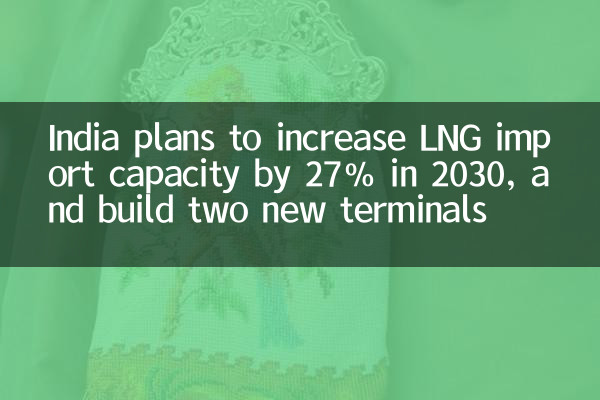India plans to increase LNG import capacity by 27% in 2030, and build two new terminals
Recently, the Indian government announced an ambitious liquefied natural gas (LNG) import plan, aiming to increase LNG import capacity by 27% by 2030 and build two new import terminals. The move aims to meet India's growing energy demand while driving its energy mix to a cleaner fuel. The following is a detailed analysis of this plan.
1. Background and goals

India is the world's third largest energy consumer. With the rapid economic development and population growth, its energy demand continues to rise. In order to reduce dependence on coal and reduce carbon emissions, the Indian government is vigorously promoting the import and use of LNG. According to the latest plan, India plans to increase LNG import capacity from the current 42.5 million tons/year to 54 million tons/year by 2030, an increase of 27%.
2. Create a new LNG terminal plan
To achieve this goal, India will build two new LNG import terminals, located in the eastern and western coastal areas respectively. Here are the basic information about the two new terminals:
| Terminal name | Geographical location | Expected production time | Designed production capacity (10,000 tons/year) |
|---|---|---|---|
| Eastern Terminal | Odisha | 2027 | 750 |
| Western Terminal | Gujarat | 2028 | 900 |
3. Upgrade of existing LNG terminals
In addition to creating new terminals, India will also expand and upgrade existing LNG terminals. The following are the current status and upgrade plans of major LNG terminals in India:
| Terminal name | Current production capacity (10,000 tons/year) | Target capacity for 2030 (10,000 tons/year) | Increase |
|---|---|---|---|
| Dah terminal | 1750 | 2200 | 25.7% |
| Hajira Terminal | 1000 | 1300 | 30% |
| Cochin Terminal | 500 | 600 | 20% |
4. Energy demand and market impact
LNG demand in India is expected to grow significantly over the next decade. According to the International Energy Agency (IEA), natural gas consumption in India will grow from 64 billion cubic meters in 2023 to 85 billion cubic meters in 2030, with an average annual growth rate of about 4.1%. This growth will mainly come from the electricity, industry and urban gas sectors.
Here are the sub-sector forecasts for natural gas demand in India:
| field | Demand in 2023 (100 million cubic meters) | Demand in 2030 (100 million cubic meters) | growth rate |
|---|---|---|---|
| electricity | 200 | 270 | 35% |
| industry | 250 | 320 | 28% |
| City Gas | 150 | 220 | 46.7% |
5. Challenges and Opportunities
Despite its ambitious plans for LNG imports in India, it still faces some challenges. First of all, the global LNG market price fluctuates greatly, which may affect India's import costs. Secondly, the construction progress of domestic natural gas pipeline infrastructure needs to be accelerated to ensure that LNG can be efficiently transported to the consumption center.
However, this plan also brings opportunities for India. By increasing LNG imports, India can further reduce its dependence on coal, improve air quality, and occupy a more favorable position in the global energy transition. In addition, the construction of new terminals and upgrading existing facilities will create a large number of jobs and promote the development of related industries.
6. Summary
India's LNG import capacity enhancement program is an important part of its energy strategy, aiming to meet growing energy demand and drive the clean energy transformation. By building two new terminals and upgrading existing facilities, India will achieve a significant improvement in LNG import capacity by 2030. Despite the challenges, this plan lays a solid foundation for India's energy security and sustainable development.

check the details

check the details